
1999/04/07 14:43:18 37.20N 128.83E 2 3.70 Korea
SLU Moment Tensor Solution
1999/04/07 14:43:18 37.20N 128.83E 2 3.70 Korea
Best Fitting Double Couple
Mo = 3.98e+21 dyne-cm
Mw = 3.70
Z = 2 km
Plane Strike Dip Rake
NP1 203 80 -165
NP2 110 75 -10
Principal Axes:
Axis Value Plunge Azimuth
T 3.98e+21 4 336
N 0.00e+00 72 234
P -3.98e+21 18 67
Moment Tensor: (dyne-cm)
Component Value
Mxx 2.74e+21
Mxy -2.79e+21
Mxz -2.16e+20
Myy -2.39e+21
Myz -1.16e+21
Mzz -3.46e+20
##############
# T ##############----
#### ############---------
###################-----------
####################--------------
####################----------------
####################------------- --
-###################-------------- P ---
---################--------------- ---
-------############-----------------------
----------#########-----------------------
-------------#####------------------------
-----------------#------------------------
----------------######------------------
---------------##############-----------
-------------#########################
------------########################
----------########################
--------######################
------######################
---###################
##############
Harvard Convention
Moment Tensor:
R T F
-3.46e+20 -2.16e+20 1.16e+21
-2.16e+20 2.74e+21 2.79e+21
1.16e+21 2.79e+21 -2.39e+21
|
The focal mechanism was determined using broadband seismic waveforms. The location of the event and the station distribution are given in Figure 1.

|
|
|
STK = 110
DIP = 75
RAKE = -10
MW = 3.70
HS = 2
The waveform inversion is preferred. This solution agrees with the surface-wave solution. This solution is well determined. Note that this date was duing the installation of the KMA network. Using the IRIS INCN station as a reference, it was determined that all KMA polarities should be flipped.
The program wvfgrd96 was used with good traces observed at short distance to determine the focal mechanism, depth and seismic moment. This technique requires a high quality signal and well determined velocity model for the Green functions. To the extent that these are the quality data, this type of mechanism should be preferred over the radiation pattern technique which requires the separate step of defining the pressure and tension quadrants and the correct strike.
The observed and predicted traces are filtered using the following gsac commands:
hp c 0.02 3 lp c 0.10 3The results of this grid search from 0.5 to 19 km depth are as follow:
DEPTH STK DIP RAKE MW FIT
WVFGRD96 0.5 105 75 -15 3.67 0.6956
WVFGRD96 1.0 105 70 -15 3.69 0.7069
WVFGRD96 2.0 110 75 -10 3.70 0.7121
WVFGRD96 3.0 105 75 -15 3.72 0.7045
WVFGRD96 4.0 110 80 -15 3.73 0.6968
WVFGRD96 5.0 110 80 -15 3.74 0.6880
WVFGRD96 6.0 110 80 15 3.74 0.6784
WVFGRD96 7.0 110 85 15 3.75 0.6721
WVFGRD96 8.0 110 85 15 3.76 0.6665
WVFGRD96 9.0 110 85 15 3.76 0.6610
WVFGRD96 10.0 110 85 15 3.77 0.6554
WVFGRD96 11.0 110 85 15 3.78 0.6492
WVFGRD96 12.0 110 85 15 3.79 0.6418
WVFGRD96 13.0 110 85 15 3.79 0.6339
WVFGRD96 14.0 110 85 15 3.80 0.6261
WVFGRD96 15.0 285 80 -20 3.80 0.6178
WVFGRD96 16.0 285 80 -20 3.81 0.6129
WVFGRD96 17.0 285 80 -20 3.82 0.6082
WVFGRD96 18.0 285 80 -20 3.82 0.6038
WVFGRD96 19.0 285 80 -20 3.83 0.6010
The best solution is
WVFGRD96 2.0 110 75 -10 3.70 0.7121
The mechanism correspond to the best fit is

|
|
|
The best fit as a function of depth is given in the following figure:

|
|
|
The comparison of the observed and predicted waveforms is given in the next figure. The red traces are the observed and the blue are the predicted. Each observed-predicted componnet is plotted to the same scale and peak amplitudes are indicated by the numbers to the left of each trace. The number in black at the rightr of each predicted traces it the time shift required for maximum correlation between the observed and predicted traces. This time shift is required because the synthetics are not computed at exactly the same distance as the observed and because the velocity model used in the predictions may not be perfect. A positive time shift indicates that the prediction is too fast and should be delayed to match the observed trace (shift to the right in this figure). A negative value indicates that the prediction is too slow. The bandpass filter used in the processing and for the display was
hp c 0.02 3 lp c 0.10 3

|
|
|

|
| Focal mechanism sensitivity at the preferred depth. The red color indicates a very good fit to thewavefroms. Each solution is plotted as a vector at a given value of strike and dip with the angle of the vector representing the rake angle, measured, with respect to the upward vertical (N) in the figure. |
NODAL PLANES
STK= 109.75
DIP= 75.92
RAKE= 159.36
OR
STK= 204.99
DIP= 70.00
RAKE= 15.00
DEPTH = 2.0 km
Mw = 3.70
Best Fit 0.9471 - P-T axis plot gives solutions with FIT greater than FIT90
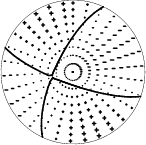 |
The P-wave first motion data for focal mechanism studies are as follow:
Sta Az(deg) Dist(km) First motion ULC 114 57 iP_C KAN 5 60 iP_C CHU 309 124 eP_- TAG 187 148 iP_C TEJ 235 160 iP_D SEO 281 173 iP_C INCN 280 197 eP_- SOS 258 213 eP_- PUS 175 234 eP_X KWA 218 285 eP_X
Surface wave analysis was performed using codes from Computer Programs in Seismology, specifically the multiple filter analysis program do_mft and the surface-wave radiation pattern search program srfgrd96.
Digital data were collected, instrument response removed and traces converted
to Z, R an T components. Multiple filter analysis was applied to the Z and T traces to obtain the Rayleigh- and Love-wave spectral amplitudes, respectively.
These were input to the search program which examined all depths between 1 and 25 km
and all possible mechanisms.
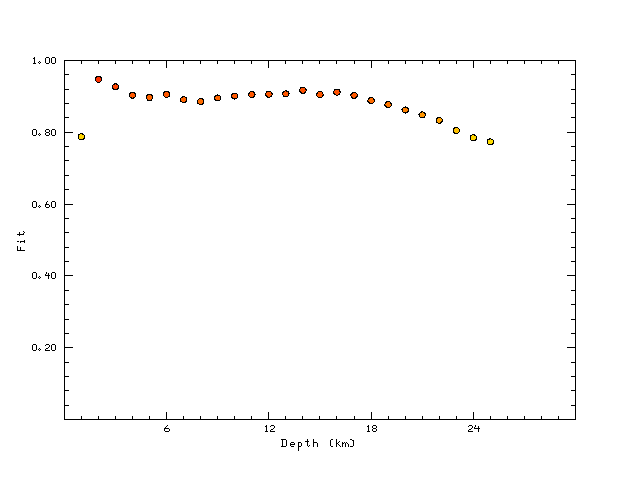
|
|
|

|
| Pressure-tension axis trends. Since the surface-wave spectra search does not distinguish between P and T axes and since there is a 180 ambiguity in strike, all possible P and T axes are plotted. First motion data and waveforms will be used to select the preferred mechanism. The purpose of this plot is to provide an idea of the possible range of solutions. The P and T-axes for all mechanisms with goodness of fit greater than 0.9 FITMAX (above) are plotted here. |
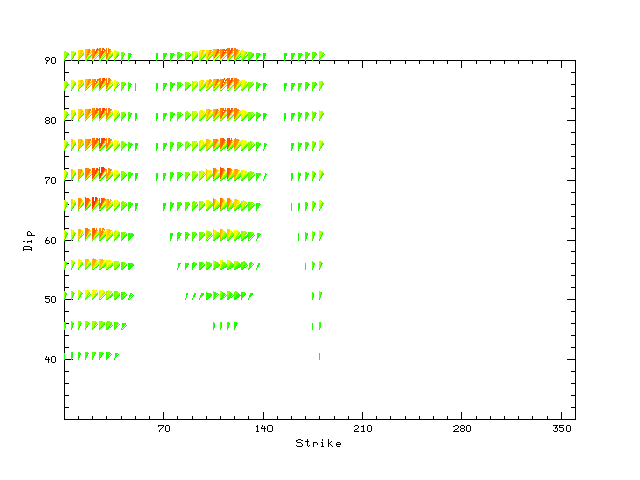
|
| Focal mechanism sensitivity at the preferred depth. The red color indicates a very good fit to the Love and Rayleigh wave radiation patterns. Each solution is plotted as a vector at a given value of strike and dip with the angle of the vector representing the rake angle, measured, with respect to the upward vertical (N) in the figure. Because of the symmetry of the spectral amplitude rediation patterns, only strikes from 0-180 degrees are sampled. |
The distribution of broadband stations with azimuth and distance is
Sta Az(deg) Dist(km) ULC 114 57 KAN 5 60 CHU 309 124 TAG 187 148 TEJ 235 160 SEO 281 173 INCN 280 197 SOS 258 213 PUS 176 234 KWA 218 285
Since the analysis of the surface-wave radiation patterns uses only spectral amplitudes and because the surfave-wave radiation patterns have a 180 degree symmetry, each surface-wave solution consists of four possible focal mechanisms corresponding to the interchange of the P- and T-axes and a roation of the mechanism by 180 degrees. To select one mechanism, P-wave first motion can be used. This was not possible in this case because all the P-wave first motions were emergent ( a feature of the P-wave wave takeoff angle, the station location and the mechanism). The other way to select among the mechanisms is to compute forward synthetics and compare the observed and predicted waveforms.
The fits to the waveforms with the given mechanism are show below:
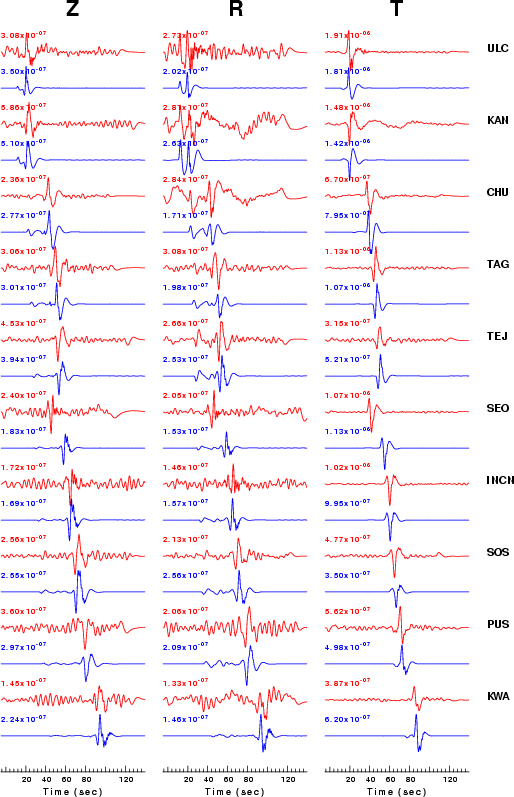
|
This figure shows the fit to the three components of motion (Z - vertical, R-radial and T - transverse). For each station and component, the observed traces is shown in red and the model predicted trace in blue. The traces represent filtered ground velocity in units of meters/sec (the peak value is printed adjacent to each trace; each pair of traces to plotted to the same scale to emphasize the difference in levels). Both synthetic and observed traces have been filtered using the SAC commands:
hp c 0.02 3 lp c 0.10 3
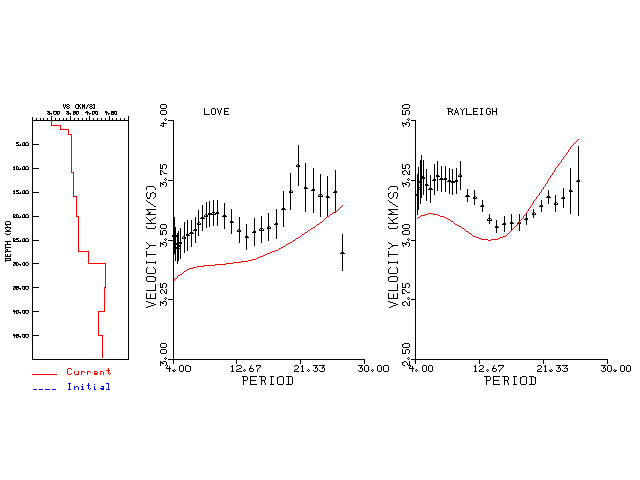
|
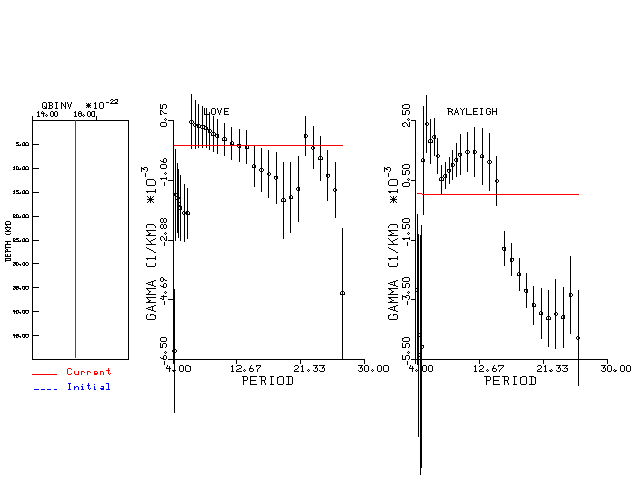
|
The figures below show the observed spectral amplitudes (units of cm-sec) at each station and the
theoretical predictions as a function of period for the mechanism given above. The modified Utah model earth model
was used to define the Green's functions. For each station, the Love and Rayleigh wave spectrail amplitudes are plotted with the same scaling so that one can get a sense fo the effects of the effects of the focal mechanism and depth on the excitation of each.
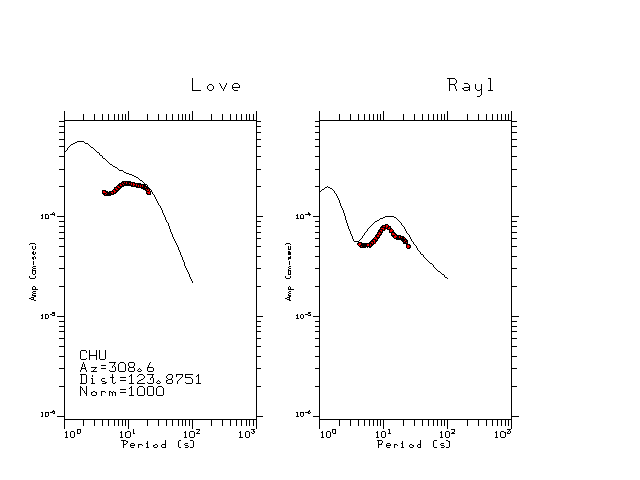 |
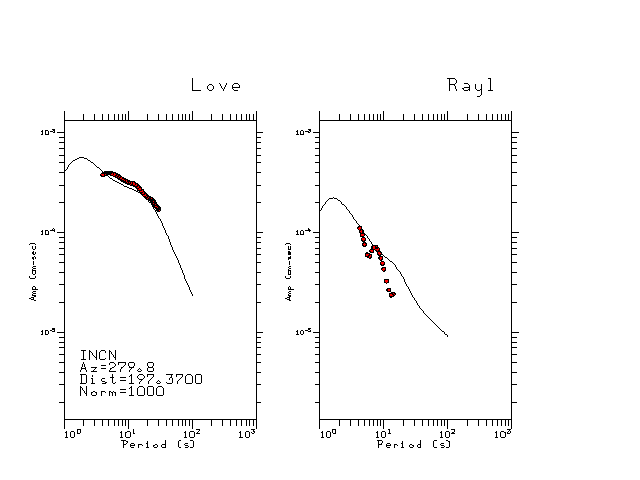 |
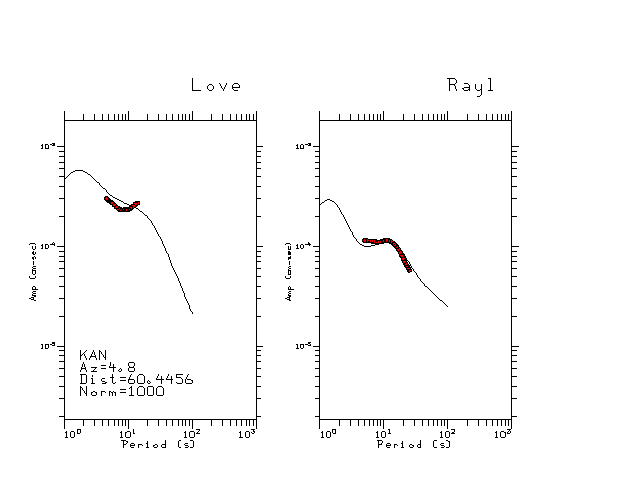 |
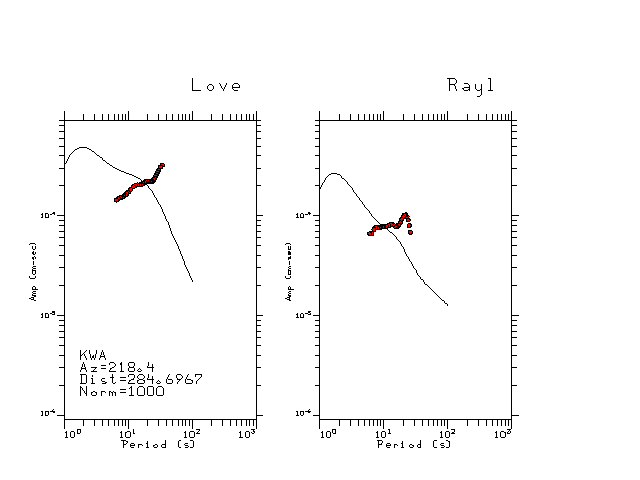 |
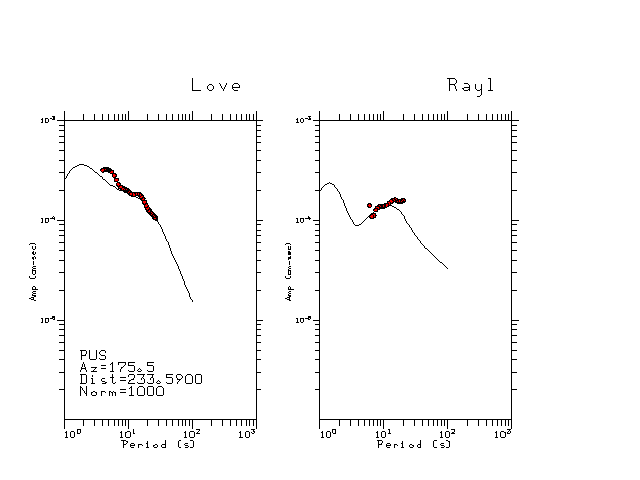 |
 |
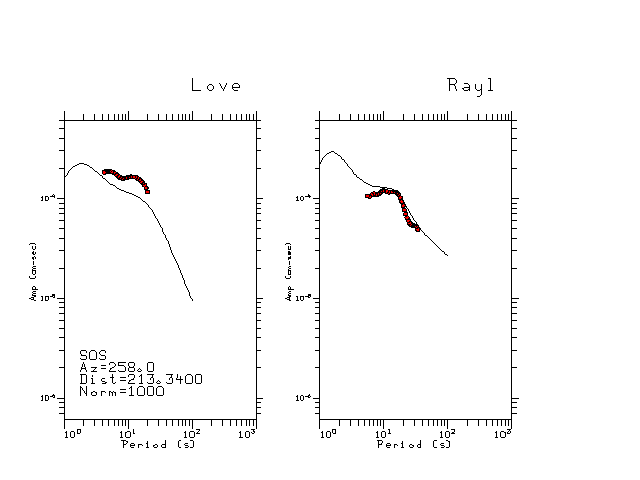 |
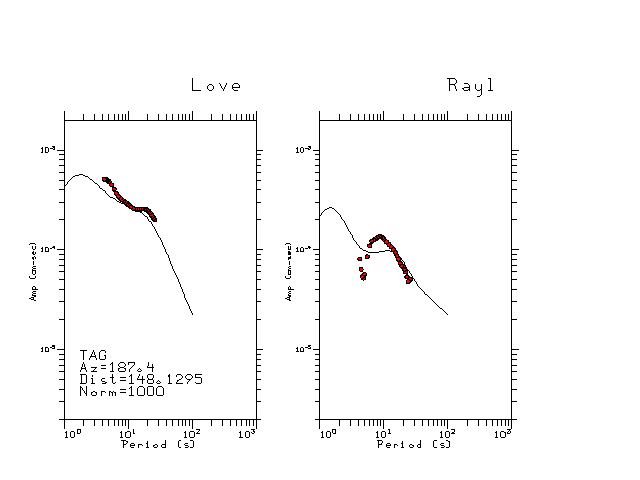 |
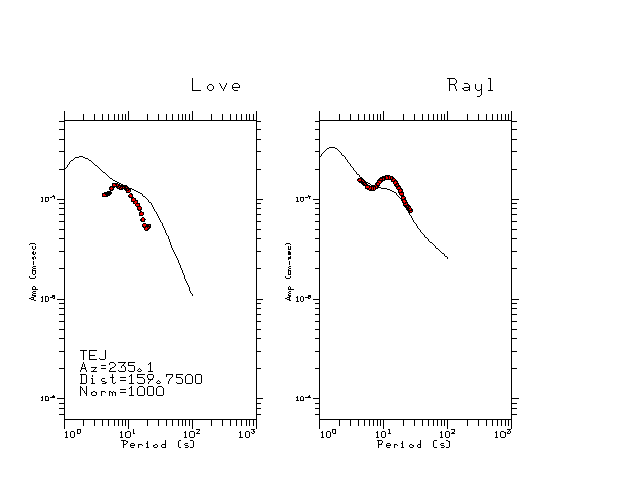 |
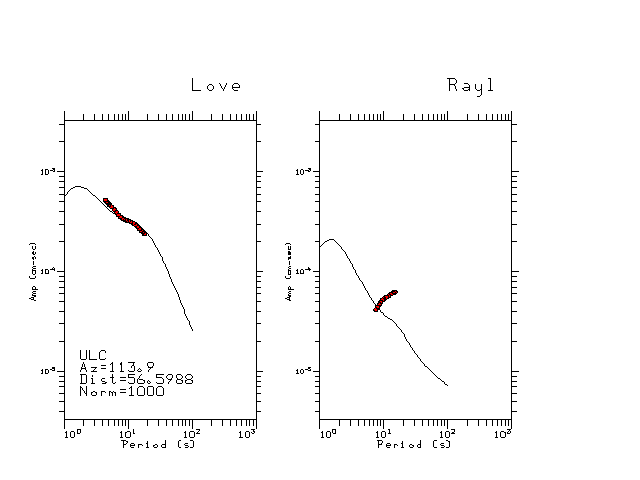 |
Here we tabulate the reasons for not using certain digital data sets